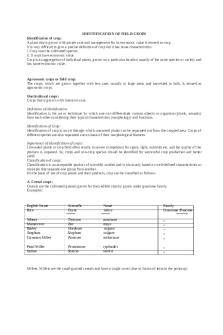3. 3. 4. Physical Identification DOCX

| Title | 3. 3. 4. Physical Identification |
|---|---|
| Author | Rowell Mahipus |
| Pages | 31 |
| File Size | 112.7 KB |
| File Type | DOCX |
| Total Downloads | 76 |
| Total Views | 326 |
Summary
LESSON PLAN TITLE : Physical Identification COURSE : Criminal Investigation Course MODULE : 3 - (Investigative Procedures) LESSON PLAN NUMBER : 6 TARGET AUDIENCE : Investigators and personnel assigned in Investigation Offices/Units. Preferably with the ranks of PO1-PO3 DATE AND VENUE : As scheduled ...
Description
LESSON PLAN TITLE : Physical Identification COURSE : Criminal Investigation Course MODULE : 3 - (Investigative Procedures) LESSON PLAN NUMBER : 6 TARGET AUDIENCE : Investigators and personnel assigned in Investigation Offices/Units. Preferably with the ranks of PO1-PO3 DATE AND VENUE : As scheduled TIME ALLOTTED : 4 hours LEARNING AIDS REQUIRED : Overhead Projector, laptop, handouts, white board & marker/eraser PARTICIPANTS EQUIPMENT REQUIRED: Tickler/notebook, ballpen, learning and training materials, handouts TRAINING REFERENCES USED : PNP Criminal Investigation Manual, ICITAP Basic Criminal Investigation ICITAP Basic Criminal Investigation Course, and PNP Crime Lab Physical Course, and PNP Crime Lab Physical Identification Division Training Material Identification Division Training Material INTRODUCTION: The value of physical evidence is determined by how useful it is in verifying that a crime has been committed, identifying the person(s) who did it, and exonerating all other persons who may be under suspicion. Physical identification has great potential in all these regards. But to realize its full potential, the police, the crime laboratory examiner, and the prosecutors must work together to produce a set of facts that make it unreasonable to believe any conclusion other than the one the facts support–even though any one of the facts may be open to reasonable doubt. One of the most common types of physical evidence that an investigator and/or crime scene specialist will encounter will be trace evidence. Trace evidence is a generic term for small, often microscopic material. Trace evidence at a crime scene can include such obvious things as blood, hair, glass particles, or paint. Trace evidence can also include less obvious or less thought of, items such as minute fibers, or even soil. The physical identification examination embraces broad range of examinations for it deals with determinations of anything under the sun. The physical identification component compares reports of something missing (person, properties) against each other for possible matches. Possible matches can be made from comparison of physical characteristics (color of the skin, eyes) and other physical identifiers (clothing, jewelry, tattoos). LEARNING GOAL:...
Similar Free PDFs

3. 3. 4. Physical Identification
- 31 Pages

Physical Education 3 4 Notes
- 59 Pages

Physical – lecture 3
- 3 Pages

Chapter 3 Physical Evidence
- 3 Pages

Physical Science Module 3-Edited
- 24 Pages

3 3 4 A Med History 4
- 2 Pages

Chapter 3 & 4 - Lecture notes 3-4
- 10 Pages

3-4 Treaties - Lecture notes 3-4
- 7 Pages

Indorg - Class 3&4 - Appunti 3-4
- 2 Pages
Popular Institutions
- Tinajero National High School - Annex
- Politeknik Caltex Riau
- Yokohama City University
- SGT University
- University of Al-Qadisiyah
- Divine Word College of Vigan
- Techniek College Rotterdam
- Universidade de Santiago
- Universiti Teknologi MARA Cawangan Johor Kampus Pasir Gudang
- Poltekkes Kemenkes Yogyakarta
- Baguio City National High School
- Colegio san marcos
- preparatoria uno
- Centro de Bachillerato Tecnológico Industrial y de Servicios No. 107
- Dalian Maritime University
- Quang Trung Secondary School
- Colegio Tecnológico en Informática
- Corporación Regional de Educación Superior
- Grupo CEDVA
- Dar Al Uloom University
- Centro de Estudios Preuniversitarios de la Universidad Nacional de Ingeniería
- 上智大学
- Aakash International School, Nuna Majara
- San Felipe Neri Catholic School
- Kang Chiao International School - New Taipei City
- Misamis Occidental National High School
- Institución Educativa Escuela Normal Juan Ladrilleros
- Kolehiyo ng Pantukan
- Batanes State College
- Instituto Continental
- Sekolah Menengah Kejuruan Kesehatan Kaltara (Tarakan)
- Colegio de La Inmaculada Concepcion - Cebu






